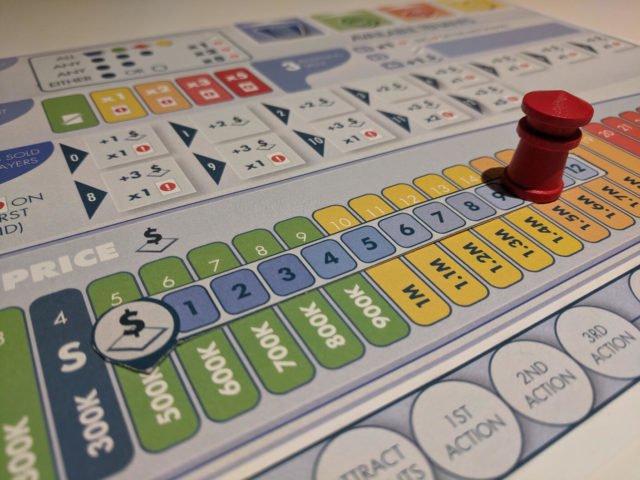We get quite a few requests to review games here at the DWP. A lot of the time the descriptions turn me off because they’re too self-congratulatory: “Blankety Blank is a hilarious party game which will have you and your friends in stitches from the moment you open the box!”
Or: “In Generic Euro players take the role of medieval merchants trying to earn the most King’s Favor by–” I’m-a gonna stop you right there.
This one, however, piqued my interest:
It’s a city building / property game where players are competing to be the wealthiest property developers when the game ends. They buy up land and choose the right buildings to construct on their land from a range of different types (industrial, residential etc – all 3D miniatures) in the hopes of driving the largest return on investment. The game builds builds towards a market crash that players are trying to predict so they can time their exit from the market just right. When that crash happens, the game ends.
Genre wise, it’s a midweight economic game with a broadly euroish structure, although a lot of elements you would not expect to see in a classical euro.
The “speculate-’til-you-crash” mechanic is one I like (see Ponzi Scheme). I was also curious about the unspecified “elements you would not expect to see in a classical euro”. Would there be a hidden traitor involved? Interpretive dance? In any event I said, “Sure, send along a copy.”
And eventually the boxes arrived. Not box–boxes. Magnate: The First City took up two medium-sized mail cartons, both crammed with components–mostly excellently-rendered 3D buildings in four colours (five, if you include the single grey City Hall which has no purpose other than to sit in the middle of the board). I puzzled over the mysterious slots in the buildings’ roofs–were those meant to be air vents? That penny did not drop until later.

I set up a solo game and away I went. When I finished 90 minutes later I was convinced: the design’s core mechanisms were solid. A few days later I taught it to and played it with three human opponents and came away just as impressed.
Normally I don’t spend much time here going through a game’s minutiae with a fine-tooth comb; but because this is a new design launching soon on Kickstarter I think I owe it to prospective backers to run through gameplay in more detail.
Magnate is a game for up to five players, played in Rounds. The board consists of seven 3×3 neighbourhood boards arranged in a honeycomb formation. The central grid is the same every game, consisting of the “Old City”: 2 blocks of apartments, 2 small factories, 2 commercial districts, 2 retail malls, and that grey City Hall I mentioned above. The buildings on these plots provide the initial population that will drive expansion outward, as explained below.
The other six neighbourhoods are randomly chosen from a stack of eight and arranged around the Old City. Along with the fact that the initial plots for sale are also random (determined by chit pulls), this guarantees each game will be different.
Bidding for turn order comes first. Sometimes you want to go first to get first crack at new lots for sale or tenants on tap; other times you will want to go last because you will want to see what everyone else does before taking your actions.
Next comes attracting new tenants. This is definitely one of the “unexpected” elements mentioned in the elevator pitch and is one of the central mechanisms in the game. You won’t be doing it in the first Round because you don’t own any buildings yet.
Starting in the second Round, in turn order, players get a chance to attract new tenants to buildings they have completed previously. Available tenants await on a separate Property Market board. Every game begins with some of each type looking for a home, but as the game goes on the demand for space fluctuates randomly, and woe betide the player who ends up late in turn order and finds out all her prospective tenants have decided to move in somewhere else.
The tenant attraction process isn’t hard to get once you grasp it, but it does take getting used to. The rules explain it clearly enough–it’s just fiddly. First you have to figure out how many dice to roll (which depends on what type of building you own), which depends on the population of certain other types of buildings in adjacent neighbourhoods. You want to roll as many dice as possible. Then you decide how much advertising you want to devote to this particular effort; each ad chit you spend gives you a guaranteed “5” on one die (which is a Good Thing). Then you roll the dice and assemble matching sets which meet the success criteria for your type of building–possibly modified by adjacent plots in the same neighbourhood.
Whew. That sounds like a lot, right? Honestly, it’s not (well, maybe a little). It’s actually quite ingenious in modelling the demand for different types of zoning. And it’s the most complex part of the game, I swear.
The point is, each matching set lets you take one tenant from the Property Board and place it next to or under your building, and from then on you get to collect rent from that tenant starting right away, which guarantees you income every turn.
Which is great, right? Well, actually, once you’ve filled your building to its capacity, it’s almost always better to sell the whole place off as soon as possible, because the proceeds will always be higher than the rent you could have collected.

But back to the game. After bidding for turn order, attracting tenants, and collecting rent, players take three actions each, in turn order. You can always “consult” for an action to make money equal to current land value, or take advertising markers (two for free; more costs money). But the first main option is to buy a plot that has come up for sale–or, if you’re willing to pay double, buy an empty plot that’s not for sale, which I like because it somewhat mitigates the randomness of the new plot chit pulls.
Land starts off pretty cheap, but starting with the second round begins to increase in variable increments depending on events of the round. This means that simply buying a plot of land and selling it on a later turn will be profitable–and depending on how quickly prices rise you can even make money by building on it and leaving it empty for long enough. But fill it with tenants and you can be sure to make a bundle.
Building on your land is another action–and here’s where those slots in the roofs come in, because they just happen to be exactly the same size as your player markers, so when you build that office building, you get to “brand” it with your icon and it looks darn cool. Each zoning type has small and large options, with the large option being way more expensive but with higher tenant capacity which means potential for bigger profits.
Finally, you can sell plots you own. The revenue you get from selling is a multiplier of the current price of land (so the longer you wait the more money you will get). The multiplier depends on whether it’s built-on (usually it is), the tenant population, and any bonuses/penalties from adjacent plots. Large commercial and retail buildings get an extra boost. Even in the early game, this multiplies out to a huge chunk of moolah, which of course you re-invest in the market.
Once everyone has taken their actions it’s time to check in with the Property Market. The Market Board is very clearly laid out and takes you step by step through the end of Round procedure, during which you’ll find out how much the price of land has risen and if the bubble has burst. Again, this mainly depends on choices the players have made during the round. Basically, the more players have heated up the market through attracting tenants, spending on advertising, and selling off land, the higher prices will go–BUT more Risk cards (no, not those Risk cards) will also be flipped as well. Each Risk card has the potential to move the Crash marker down from its initial position of ten on its special track towards zero.
If the market doesn’t crash, new Tenant cards are flipped to tell you how much to add to the piles of prospective tenants, and new property chits are drawn to mark new plots of land that come onto the market for next Round. And it all begins again.
But if the Crash marker hits zero, it’s game over. First, land values crater–ie, go down–by an amount equal to the sum of modifiers on all the Risk cards. Then everyone sells off everything they own, and whoever has the most money wins.

So, what do I think of Magnate? Well, I wouldn’t have gone into all this detail (let alone gone ahead with this review) if I didn’t think the game was not only good but differently good. I’ve played a lot of economic sims and Magnate’s boom-and-bust mechanics work, both thematically and in terms of gameplay. There are tons of interesting decisions to make every turn, from how much to bid for turn order to where and whether to buy land, what type of building to build, how much to pay for advertising, and most importantly how long to hold onto your buildings before you sell them. There is an advanced variant where each of the four zone types is further differentiated into subtypes which provide different tenant-attraction opportunities and rental rates (more brain-burny) and an excellent Solo variant which so far I have yet to beat to my chagrin even at easiest level.
The components, even in the not-quite-ready-for-prime-time version I received, are first rate. The rules are very clearly laid out with tons of examples, which especially helps for the first couple of times you attract new tenants.
My only caveat is a personal belief, which I have shared with the designer, that the distribution of Crash numbers in the Risk deck is slightly off. The way they are now it is possible for the game to last only five Rounds–four if the market overheats more than usual. Even under normal circumstances the game generally goes seven or eight Rounds. I’m all in favour of “leaving them wanting more”–ie, I’d rather a game feel too short than too long–and I appreciate the intent is to make the game playable in 90 minutes or less. It was pointed out to me by the designer that the Crash Track actually begins at twelve, which lets players have a longer game if they want. That may well be the way I will prefer to play it in future.
For, make no mistake, this is a game I will want to play in the future. This is Naylor Games’ first publishing effort, so I can’t speak to reliability of fulfilment. But if you like midweight economic games, then you can back this knowing you’re (theoretically, caveat emptor and all that) getting a satisfying and original game.
Thanks to Naylor Games for a review copy of Magnate: The First City. The Kickstarter campaign launches November 21.
Comments
No comments yet! Be the first!